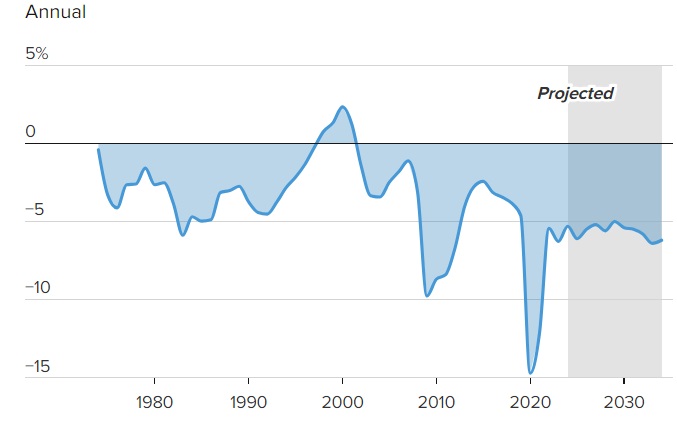
Soaring Debt and Deficits Spark Concerns Over Economic and Market Stability
Government debt that has swelled nearly 50% since the early days of the Covid pandemic is generating elevated levels of worry both on Wall Street and in Washington.
The federal IOU is now at $34.5 trillion, or about $11 trillion higher than where it stood in March 2020. As a portion of the total U.S. economy, it is now more than 120%.
Concern over such eye-popping numbers had been largely confined to partisan rancor on Capitol Hill as well as from watchdogs like the Committee for a Responsible Federal Budget. However, in recent days the chatter has spilled over into government and finance heavyweights, and even has one prominent Wall Street firm wondering if costs associated with the debt pose a significant risk to the stock market rally.
“We’re running big structural deficits, and we’re going to have to deal with this sooner or later, and sooner is a lot more attractive than later,” Fed Chair Jerome Powell said in remarks Tuesday to an audience of bankers in Amsterdam.
While he has assiduously avoided commenting on such matters, Powell encouraged the audience to read the recent Congressional Budget Office reports on the nation’s fiscal condition.
“Everyone should be reading the things that they’re publishing about the U.S. budget deficit and should be very concerned that this is something that elected people need to get their arms around sooner rather than later,” he said.

Uncharted territory for debt and deficits
Indeed, the CBO numbers are ominous, as they outline the likely path of debt and deficits.
The watchdog agency estimates that debt held by the public, which currently totals $27.4 trillion and excludes intragovernmental obligations, will rise from the current 99% of GDP to 116% over the next decade. That would be “an amount greater than at any point in the nation’s history,” the CBO said in its most recent update.
Surging budget deficits have been driving the debt, and the CBO only expects that to get worse.
The agency forecasts a $1.6 trillion shortfall in fiscal 2024 — it is already at $855 billion through the first seven months — that will balloon to $2.6 trillion by 2034. As a share of GDP, the deficit will grow from 5.6% in the current year to 6.1% in 10 years.
“Since the Great Depression, deficits have exceeded that level only during and shortly after World War II, the 2007–2009 financial crisis, and the coronavirus pandemic,” the report stated.
In other words, such high deficit levels are common mostly in economic downturns, not the relative prosperity that the U.S. has enjoyed for most of era following the brief plunge after the pandemic declaration in March 2020. From a global perspective, European Union member nations are required to keep deficits to 3% of GDP.
The potential long-term ramifications of the debt were the topic of an interview JPMorgan Chase CEO Jamie Dimon gave to London-based Sky News on Wednesday.
“America should be quite aware that we have got to focus on our fiscal deficit issues a little bit more, and that is important for the world,” the head of the largest U.S. bank by assets said.
“At one point it will cause a problem and why should you wait?” Dimon added. “The problem will be caused by the market and then you will be forced to deal with it and probably in a far more uncomfortable way than if you dealt with it to start.”
Similarly, Bridgewater Associates founder Ray Dalio told the Financial Times a few days ago that he is concerned the soaring U.S. debt levels will make Treasurys less attractive “particularly from international buyers worried about the US debt picture and possible sanctions.”
So far, that hasn’t been the case: Foreign holdings of U.S. federal debt stood at $8.1 trillion in March, up 7% from a year ago, according to Treasury Department data released Wednesday. Risk-free Treasurys are still seen as an attractive place to park cash, but that could change if the U.S. doesn’t rein in its finances.

Market impact
More immediately, there are concerns that rising bond yields could spill over into the equity markets.
“The huge obvious problem is that the U.S. federal debt is now on a completely unsustainable long-term trajectory,” analysts at Wolfe Research said in a recent note. The firm worries that “bond vigilantes” will go on strike unless the U.S. gets its fiscal house in order, while rising interest costs crowd out spending.
“Our sense is that policymakers (on both sides of the aisle) will be unwilling to address the U.S.’s long-term fiscal imbalances in a serious way until the market begins to push back hard on this unsustainable situation,” the Wolfe analysts wrote. “We believe that policymakers and the market are most likely underestimating future projected net interest costs.”
Interest rate hikes from the Federal Reserve have complicated the debt situation. Starting in March 2022 through July 2023, the central bank took up its short-term borrowing rate 11 times, totaling 5.25 percentage points, policy tightening that corresponded with a sharp rise in Treasury yields.
Net interest on the debt, which totals government debt payments minus what it gets from investment income, have totaled $516 billion this fiscal year. That’s more than government outlays for national defense or Medicare and about four times as much as it has spent on education.
The presidential election could make some modest differences in the fiscal situation. Debt has soared under President Joe Biden and had escalated under his Republican challenger, former President Donald Trump, following the aggressive spending response to the pandemic.
“The election could change the medium-term fiscal outlook, though potentially less than one might imagine,” Goldman Sachs economists Alec Phillips and Tim Krupa said in a note.
A GOP sweep could lead to an extension of the expiring corporate tax cuts Trump pushed through in 2017 — corporate tax receipts have about doubled since then — while a Democratic win might see tax increases, though “much of this would likely go toward new spending,” the Goldman economists said.
However, the biggest issue with the budget is spending on Social Security and Medicare, and “under no scenario” regarding the election does reform on either program seem likely, Goldman said.


